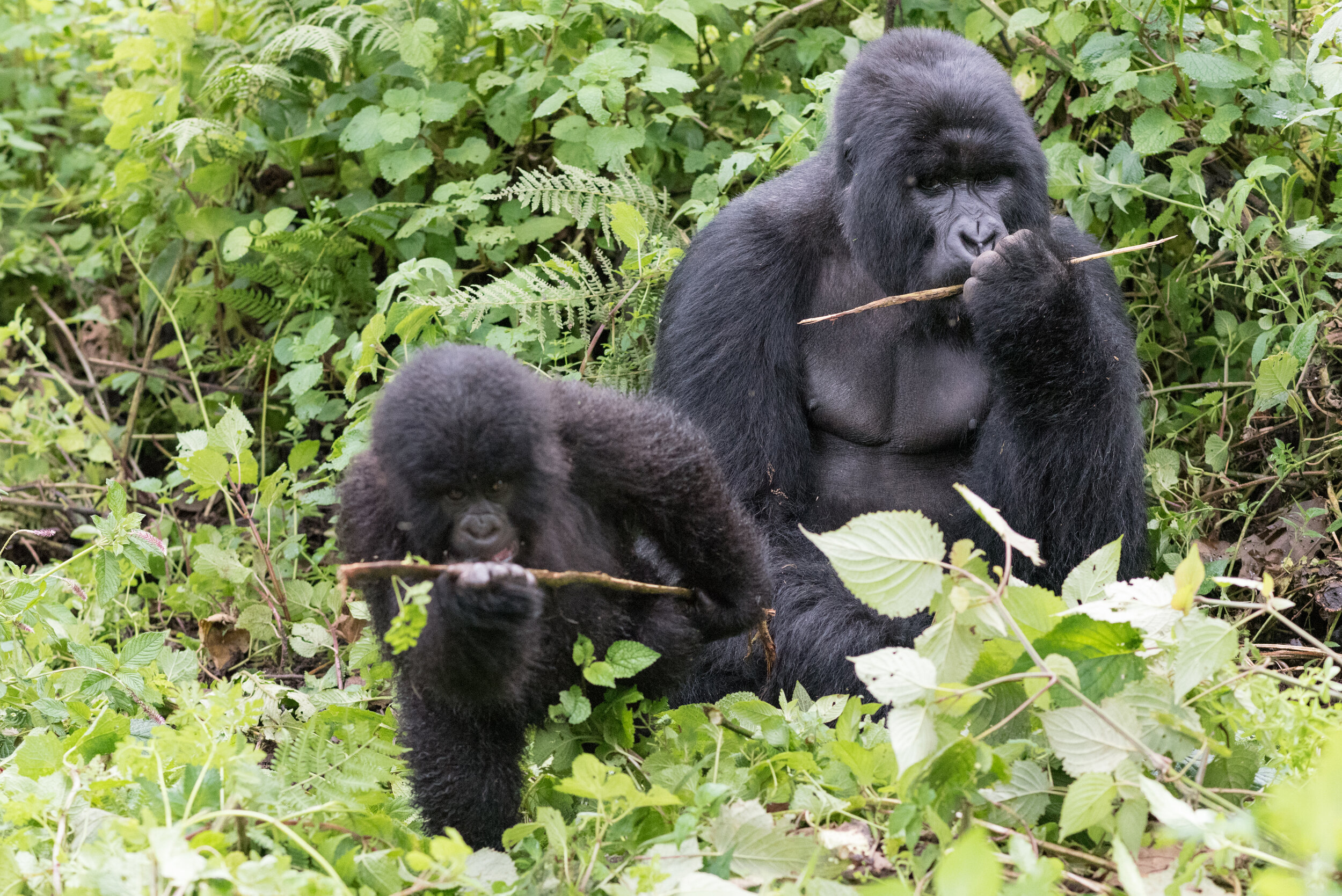The night before making the nerve-wracking border crossing into the Democratic Republic of Congo, we sat on the porch of our thatched-roof hut in the Rwandan lakeside town of Gisenyi and watched the sun set over the shores of beautiful Lake Kivu. Across the lake, we could see nothing but dense green hills, the jungles of the Congo nearly in reach. We were unaware what the next 3 nights would bring us, so the calm and serenity was welcomed, as we sat on the hill and dined al fresco in yet another glamping eco-lodge.
Virunga National Park is the oldest National Park in Africa, and contains perhaps the widest range of flora and fauna, from elephants to hippos to gorillas, from jungle to lakes to savannah to volcanoes, a lot of them. It’s a massive park, as it stretches all along the Rwandan and Ugandan borders with the DRC. There are multiple active volcanoes, one of which destroyed the city of Goma in 2002. The park has been fighting for its life for many years now as militia groups throughout the Congo have imbedded themselves deep in the center of the park, hungry for resources, both from the land and from its inhabitants, by means of poaching for ivory and the like. Because of this unrest, humanitarian workers have struggled to gain a foothold on controlling the spread of diseases such as Ebola and Measles. Nearly every week, militia groups target civilian villages, killing many innocent people, as a means of leverage against the controlling governments in the country. Private interests, as well, have threatened the ecosystem of Virunga, particularly those in search of oil.
The park only stands a fighting chance because of its heroic rangers that have sworn to protect the land and those living on it. When I think of a park ranger, I usually think of a laid-back outdoorsman that enjoys the chance to live out in nature and keep an eye on hikers and the occasional bear. What does not come to mind is a highly trained soldier who must wield an automatic weapon at all times, in constant search for intruders coming into the park to steal, kill, and destroy. I do not think of someone that will protect every step I take into the jungle, ensuring not just my safety, but the safety of every living thing in the park. Such is the life, however, for the Park Rangers of Virunga. Hundreds have dedicated their lives, and many have lost them as a result, to protecting their home. The most cherished inhabitants of Virunga National Park are its Eastern Mountain Gorillas. The rangers have developed a bond and familiarity with many of the gorilla families in the park, and their need for protection is quite real, as just over a decade ago, over half a dozen gorillas were killed by militia groups, in the hope of deterring people from visiting, so they could in turn exploit the land. No gorillas, no tourists, no park, or so the logic goes. There’s a fantastic documentary on Netflix called, “Virunga” that is a great watch. Things are significantly safer now then when the documentary was filmed, but the same challenges remain.
The border crossing from Gisenyi to Goma was relatively painless, aside from being coerced into paying for a physical Yellow Fever card, rather than the scanned copies we’d been using. From there, we hopped into our safari truck and headed through the town of Goma. Things were a bit unsettling to start, as the safari truck’s plastic windows were all rolled up, making the trip an open-air experience. Throughout our trip, driving in African city traffic has required windows rolled up, to avoid the potential for thieves to reach in to snatch a bag or worse. So, naturally, in the most dangerous region we’d travelled to, where kidnapping was a real threat, we drove through town in a damn convertible. The worry was unwarranted however, as most everyone just waved at us as we drove through town, aside from a group of guys that didn’t take too kindly to one of our fellow passenger’s incessant and invasive picture taking of everyone on the side of the road. After making our way through an Ebola handwashing station, we met up with the caravan of rangers that would escort us to our lodging in the park. The road turned from paved to potholed, and the rain came. Though the ride was a bit bumpy, it was a relief to be out of the city and on our way into the park, as volcanoes dotted the horizon and storm clouds swirled.
As we made our way closer to the lodge, we passed through a few small villages, and were given a king’s welcome like no other. It’s commonplace in most parts of Africa to be waved at by children and sometimes adults when driving through smaller towns. People will yell or wave or put their hands out as you pass by. What we experienced on our way to Kibumba Camp however, blew all this out of the water. They must ring a bell when the tourist cars are on the way, because every child within 10 miles seemed to come out to the side of the road to welcome us with waves and an endearing: “MZUUUUUUNNNNNNGGGGGGG!.” Mzungu translates as “one who wanders around” in Swahili, and is the common term for white foreigner. It’s not necessarily a term of endearment nor ridicule, merely a statement of fact. I’ll take it. With every mud-filled turn, a new set of kids would run from their modest wooden shacks yelling and waving our direction, complete joy in their smiles. Some children would show off their spinning tops, or “dogs” made from recycled plastic, leash and all. Others jumped rope, while a few chased the car. Each and every one, though, would peak their heads out, eyes lit up, and yell at the top of their lungs. The highlight came just before we approached the gate to our camp, as a whole group of a dozen or so kids were already on the roadside, mid dance routine, waiting for us to pass. No choreography required, every kid had his or her own rhythm and funk. The experience was euphoric, some of the most pure and innocent happiness one can experience. I am not sure who made who happier, as the joy was mutual. After settling in, we took a walk of the village, where cries of “Mzung!” reverberated throughout, as we learned of the crops grown and lifestyle lived. The poverty is stark, and the distended bellies of the children, even with the large food supplies, was heartbreaking, though not necessarily in the moment, as the sheer joy in the kids’ faces prevailed. At one point, a group of kids asked, through lots of pointing and grabbing, to take a photo of them. They all posed, each one showing off a distinct personality. As I bent down to show them the photo, I was mobbed by all of them, even kids that weren’t in the photo. In all the chaos and button pushing, the kids somehow deleted their own photo! Thankfully, the memory remains of the face of joyous innocence.
The following morning, we completed our trek to visit the gorillas, and remained in awe for most of the afternoon, before beginning our preparation for the primary activity the trip into the Congo and a visit to Virunga National Park was geared towards, the main reason the whole ordeal was worth the risk involved: Mount Nyiragongo.
Nyiragongo is an active volcano with a massive crater containing the world’s largest lava lake. From our camp that night, we watched as darkness fell and the clouds surrounding the volcano turned a blood red. As we stood and watched from afar, we could have been easily convinced that the volcano was erupting that very moment. The stars and clouds and silhouettes of the surrounding peaks, all dominated by the bright red smoke coming from the cone made for a surreal nightcap, and a slightly uneasy stomach knowing that we’d be spending the following night camped out on top of the glowing red fireball.
We began the hike mid-morning, with pleasant weather and a handful of new friends that came to the Congo to hike the volcano and get out the next day. We hiked, with a healthy number of rangers, guns in tow, up the mountain, along volcanic rock and thick jungle. We passed a gaping hole, where the lava had flowed from in 2002, down into and through the city of Goma below. About ¾ of the way through the hike, we were caught in a massive hailstorm, just after I’d decided not to put my full poncho on. Sufficiently soaked, we slogged our way out of the trees and ever so close to the summit. As we approached the rim, we could hear a low rumble, along with what sounded like crashing waves. As if the sun came out from the clouds to shine on our faces, we felt a warmth that seemed out of place. Standing on the rim, we stared down into a basin of thick fog, the rumbling and crashing waves clearly audible now. Looking confused at the ranger, I was told to “just wait.” So I did. I sat and stared at the fog that was making all that noise at me, and waited for the volcano to show me what it was hiding.
Slowly the fog dissipated, revealing what looked like an etch-a-sketch of cracked earth, only instead of black lines they were deep red. The giant lake tried to shake itself into all different shapes and patterns, crashing against the walls, splashing glowing lava high into the air. We watched for a while, soaking in the views of volcanoes, massive lakes, and endless jungle around us, before retreating into our metal A-frame structures to drink some tea and prepare dinner before the light show that would come once darkness fell. After a meal and a short siesta, serenaded by the low rumble and crashing waves of the lava just outside, I poked my head outside to a sky that looked as though a rocket had just been launched; everything was a deep red. Quickly climbing up to the rim of the crater, I was almost blinded by the bright orange fire of the lake below. No fog in sight, I stared straight into the center of the earth, the fiery, bubbling, lurching lake of fire, of liquid hot magma. The lava spewed onto the cooled earth in the immediate vicinity of the lake’s walls, like an artist throwing paint onto canvass. Elsewhere in the crater, a mini cone had formed, spraying lava out its top and leaking a river of fire around the crater walls. The whole experience was like nothing I’ve ever witnessed, no photo or video will do it justice, no story will capture what it’s like to stare into hell. We stared for hours, then came back and stared again. And again. It was complete sensory overload. Our faces absorbed the heat, our noses turned up at the sulfur, our ears were deafened by the crashing lava, our eyes blinded by the fire, and our tongues satiated with the taste of sweet victory in making it to the top of the volcano, and through the dangers of Virunga, alive and well.
After the most spectacular 48 hours of our lives, after being up close and personal with gorillas and volcanoes, perhaps more alive and well than ever before.
Long Live Virunga




























